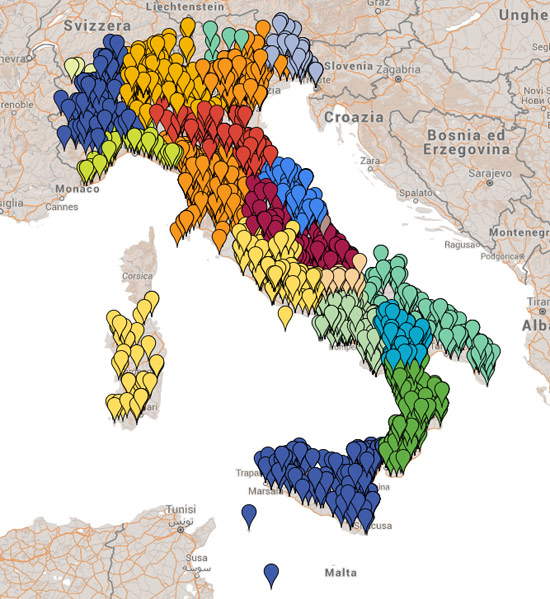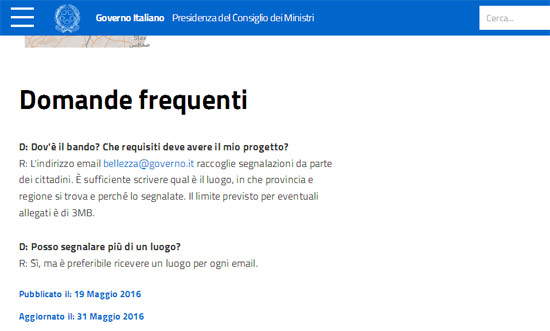It finally comes to an end bellezza@governo.it: yet another renzian marketing tool
One of the sleaziest initiatives hatched from the mind of the current prime minister has finally come to an end: bellezza@governo.it. That is, an e-mail address to which to send reports of cultural projects to be funded, or of cultural places in need of restoration: those deemed most interesting, or most in need, will share the 150 million euros that the government wanted to allocate to the operation. The “winning” projects will be selected, as we read from the initiative’s web page, by an “ad hoc committee”: however, it is not yet known by whom this committee will be composed. The funds will be allocated by a decree to be issued on August 10.
It seems that Italians have been busy: as of May 31, as many as 139,759 emails have arrived at the above address, with a total of 2,782 reported places. Which were reported above an awkward, Google Maps-style map(with colored markers to point to various locations), albeit unenlarged and unclickable. A brilliant masterpiece of futility, in short. However, beyond this colorful footnote, the question that arises for any citizen not yet completely blinded by Renzian marketing sounds something like this: but is this really the model we need to manage our cultural heritage?
 |
| The spectacular, non-clickable map on the initiative’s website |
There are several at least questionable aspects to this affair. The first: one does not understand what sense there is in this bizarre televoting that is supposed to reward certain places over others. It is, in essence, the Sanremo Festival model applied to the management of public cultural property. An atrocious idea whose usefulness we do not understand: in the end, the reported places will still be screened by a commission (whose composition, we repeat, we do not know at the moment) whose task it will be to decide to whom the funds will be allocated. So does the government think that the officials of the Ministry of Culture (because we want to hope that the members of the commission come from that department) do not know which places to intervene on? Or is this simply a clumsy attempt to make people believe that the government email address is a real tool for participation? The example was given of the FAI Places of the Heart, from which the government initiative would be inspired. But Places of the Heart allocates funds to projects that get the most referrals (or at least a minimum number of votes), so at least in this case it is really the voters who decide. However, this is a model that cannot be applied to the management of public heritage: the state, whose duties towards the protection and preservation of heritage are enshrined in the Constitution, has special staffs of technicians who by profession deal with cultural heritage. In other words, it does not have to be the televote to decide: the Ministry already has both the tools to intervene and the people with the ability to discern what the priorities are. FAI, on the other hand, is a private, nonprofit foundation that pursues certain purposes, and does not have the professionalism within it that the Ministry can count on: in short, it is an organization that is not required to know what the priorities are, and therefore makes contributions on the basis of citizens’ reports, while still working in contact with the bodies that are responsible for protection. Let’s say that at best, if you want to look at it in a certain way, bellezza@governo.it is nothing more than a kind of institutionalization (with a propaganda flavor) of what many citizens already do: report critical issues affecting cultural property to the Superintendencies.
Having thus ascertained the complete uselessness of the email address, and thus of the very structure of the initiative, a further doubt arises about the seriousness of the operation. As mentioned at the beginning, at the email bellezza@governo.it one could report not only buildings in need of restoration, but also cultural projects to be financed. In short, if the citizen’s reporting seems to make little sense for restorations (given that, if there are extraordinary funds, ministry officials should be clear about priorities), it may not, on the other hand, be entirely balky for “cultural projects.” It is unclear, however, what characteristics a project must meet to receive a grant, because there is no call for proposals outlining the specifics. And if there is, it must be well hidden, since on the page dedicated to the initiative, in the two skimpy faqs that appeared until yesterday (and were hastily removed today as the deadline expired) there was no reference to calls for proposals. One of the two faqs specifically asked “where is the notice”: since the answer was not provided, it is safe to assume that the notice, in fact, does not exist. So much for transparency! In short: there are no calls for bids (or they are not readily available), there are no lists of specifications, it is not known by whom the commission will be composed, which, if it will be unique, will have to decide on very different operations, such as restoring a church or, we quote from the example given by Matteo Renzi himself in theinterview in which he launched bellezza@governo.it, supporting “the theater that a group of young people is putting up.” Restorers, architects, and art historians will be needed to understand how to work on the church (and whether the allocated grant will be sufficient); other professionals will be needed to understand how to start the theater venture. Will the committee be so inclusive?
 |
| The faqs as they appeared until yesterday |
And again: how did government employees manage to evaluate in such a short time the huge amount of mail declared on the site? The reported places were being updated day by day, and we take into account that as many as 50,081 mails arrived on May 31 alone. It means that, in order to update the reports, it was necessary to read 35 mails per minute: therefore, in the space of only two seconds, assuming that the mail-readers worked around the clock, it became necessary to open the letter, read it along with any attachments (the government has set a limit of 3 megabytes for files attached to the mail: Renzi must have wanted to save time at the download stage!), enter (we assume) the report into a database with all the data (or, at least, with the bare minimum: the address from which it came), update the count. If it really was possible, in such a short time, to read every single email and update the count as accurately as possible in real time, day by day, the government will really have to tell us how this happened: it would be, said without irony, an admirable example of efficiency, speed and accuracy.
In essence: we can regard bellezza@governo.it as yet another marketing operation of this government. And for all the above reasons, we at Finestre Sull’Arte have not sent any reports: we make no secret of it. Also because, to conclude, enormous is the disparity between the few projects(thirty-three in total) that will receive 85 percent of the billion made available for culture, and the rest of the widespread heritage (hundreds of sites: after all, there were 2,782 reported sites) that will have to share what remains. So, unfortunately, bellezza@governo.it also seems to be shaping up as yet another propaganda tool of a government whose actions increasingly resemble a massive electoral campaign in favor of the current majority: too bad that it is, once again, cultural heritage, treated as ditties to be triumphed over by televoting, that will be the loser.
Warning: the translation into English of the original Italian article was created using automatic tools. We undertake to review all articles, but we do not guarantee the total absence of inaccuracies in the translation due to the program. You can find the original by clicking on the ITA button. If you find any mistake,please contact us.




























